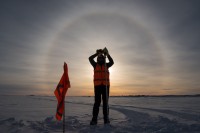Forecasters on the way to a totally 'cool' summer
30/10/2017

The Antarctic summer program has launched this week for the Bureau of Meteorology as forecasters begin their journey to the icy wonderland.
Five forecasters from around the country are making their way via air and sea for the four month placements at Davis and Casey stations where they will provide weather services for the safe and efficient running of the Australian Antarctic program.
Two of the forecasters currently undertaking the 14-day voyage to Davis Station on the Aurora Australis, Deborah Holmes from Tasmania and Louise Carroll from Canberra, are excited for the challenges ahead.
"Antarctica is a special place to have the privilege of working. It is unlike any other place on Earth and is still one of the last places virtually pristine and untouched by humans," Ms Carroll said.
"It is a unique and challenging environment to live in and one that challenges me both personally and professionally.
"I can't wait to interact with the people down there and explore the base, but I know there will also be a lot of work to do as we will forecast for each of the three Antarctica stations [Davis, Casey and Mawson], provide field camp and marine forecasts, and all support for planes and helicopters in and out of the continent.
"It's going to be very busy."
While this is Ms Carroll's fourth trip to Antarctica during her decade-long career with the Bureau, it will be a new experience for Ms Holmes who graduated from the Bureau's Meteorology Program in 2015.
Ms Holmes said she welcomes the opportunity to further cement her skills in forecasting in such a remote location, but is also keen to see what life in Antarctica is all about.
"I really wanted to work in Antarctica for the adventure and challenge of being in such a remote location, and to meet lots of new and different people," she said.
"I have heard that living on an Antarctic station is kind of like a big school camp; you're living communally with the same people for four months and participate in all kinds of household duties to ensure the station is a great place to live."
Meteorologists have been embedded in the Australian Antarctic summer program since the development of the Antarctic Meteorological Centre at Casey in 1991.
The internal recruitment process involves a stringent technical, medical and psychological assessment as part of the four to six month preparation and training period, before the five successful applicants depart Hobart for the November to March summer season.
While there will be plenty of work and interesting people to meet, it is some of the permanent local fixtures that this year's forecasters are most looking forward to.
"The interactions you have with the wildlife in Antarctica are truly special," Ms Carroll said.
"Even while you are working and living on station, you can often hear elephant seals nearby and you can encounter Adélie penguins as you move between the buildings.
"Interacting with such distinctive wildlife in their natural habitat, and in one of the few places left on earth where the human footprint is so minimal, is always a surreal experience for me and one that I will never tire of."
Antarctica facts
- The Australian Antarctic Territory covers around 5.9 million kilometres squared or roughly an area 80 per cent of the Australian mainland.
- At Casey during the summer season (November to March), most days do not get above zero and most nights drop below -5 °C
- The coldest summer season temperature on record for Casey is -25.1 °C, with the warmest 9.2 °C
It is typically not quite so cold at Davis, but most days do not get above zero and most nights drop below -4 °C - The coldest summer season temperature on record for Davis is -27.6 °C, with the warmest 13 °C
- Up to 120 expeditioners will call Davis home during summer and will enjoy a theatre, a library, spa and sauna and a game room during their free time.
- Around 150–160 expeditioners will visit Casey Station during summer, which features an indoor climbing facility, a home theatre, a gym, a ski loop and a library.










